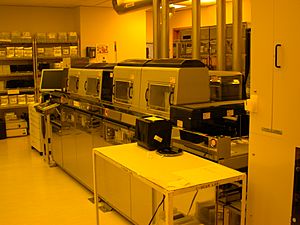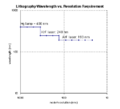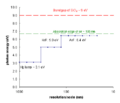
The wafer track portion of an aligner that uses 365 nm ultraviolet light
Photolithography is the combination of photography and lithography. Its uses include the mass printing of photographs. Microphototolithography is the use of photolithography to transfer geometric shapes on a photomask to the surface of a semiconductor wafer for making integrated circuits.
Manufacturing
Photolithography makes integrated circuits such as memory and central processing units.
A special light-and-shadow pattern is shone through a photomask, onto a sheet or wafer of silicon that had been covered with a material called a photoresist. The light hardens the photoresist. When the board is dipped into a special acid, the parts that had no light on them are dissolved away.
Memory chips have thousands or millions of identical cells. Because is much easier to make than a CPU, (a large die with a non-repetitive structure), RAM chips are far less expensive than processors.
Images for kids
-
The filtered fluorescent lighting, yellow LED or low-pressure sodium lighting in photolithography cleanrooms contains no ultraviolet or blue light in order to avoid exposing photoresists. The spectrum of light emitted by such fixtures gives virtually all such spaces a bright yellow color.
-
Diffraction order spectrum with partial coherence. The diffraction order spectrum (up to 3rd order) of a line-space pattern (pitch
-
Illumination direction impact. On-axis illumination provides higher contrast, but only off-axis illumination resolves the smallest pitch.
-
The Rayleigh criterion defines the minimum separation for preserving the distance between two points in the projected image.
-
Illumination can significantly impact the apparent pitch of the image of the same object (a pair of bright lines in this case).
-
Straight edges of shortened features are distorted into bowed edges as pitch is reduced in both directions.
-
Gap width vs. half-pitch. The tighter the line pitch, the wider the gap between the ends of the lines (perpendicular to the pitch).
-
Features imaged by DUV (left) have much less edge position variability than those imaged by EUV (right).
-
Photons are divided among multiple source points. The photons making up the exposure dose are divided equally among the source points (two are shown here) which are positioned within the pupil.
-
One of the evolutionary paths of lithography has been the use of shorter wavelengths. It is worth noting that the same light source may be used for several technology generations.
-
Changing the lithography wavelength is significantly limited by absorption. Air absorbs below c. 185 nm.
See also
 In Spanish: Fotolitografía para niños
In Spanish: Fotolitografía para niños
 In Spanish: Fotolitografía para niños
In Spanish: Fotolitografía para niños











